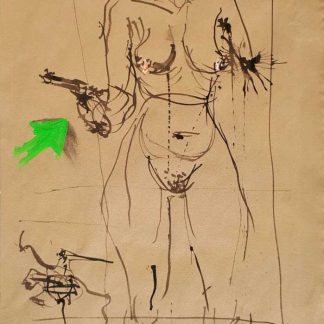
Tumarkin Igael
Biography
Peter Martin Gregor Heinrich Hellberg (later Igael Tumarkin) was born in Dresden, Germany. His father, Martin Hellberg, was a German theater actor and director. His mother, Berta Gurevitch and his stepfather, Herzl Tumarkin, immigrated to Mandate Palestine when he was two.[2] Tumarkin served in the Israeli Navy. After completing his military service, he studied sculpture in Ein Hod, a village of artists near Mount Carmel. His youngest son is actor Yon Tumarkin.
Art career
Igael Tumarkin, 1980
Among Tumarkin’s best known works are the Holocaust and Revival memorial in Rabin Square, Tel Aviv and his sculptures commemorating fallen soldiers in the Negev.[5]
Tumarkin is also a theoretician and stage designer. In the 1950s, Tumarkin worked in East Berlin, Amsterdam, and Paris. Upon his return to Israel in 1961, he became a driving force behind the break from the charismatic monopoly of lyric abstraction there. Tumarkin created assemblages of found objects, generally with violent Expressionist undertones and decidedly unlyrical color. His determination to “be different” influenced his younger Israeli colleagues. The furor generated around Tumarkin’s works, such as the old pair of trousers stuck to one of his pictures, intensified the mystique surrounding him.[6][7][8] One of his controversial works is a pig wearing phylacteries
Education
1954 – Studied with Rudi Lehmann, Ein-Hod
1955 Studied with Bertolt Brecht, Berliner Ensemble, Berlin
1955-57 Assistant to the designer Karl von Appen
Awards and recognition
1963 First Prize for Battle of Hulaykat Monument
1968 The Sandberg Prize for Israeli Art, Israel Museum, Jerusalem, Israel
1968 First Prize for Memorial to Sailors, Haifa
1971 First Prize for Memorial for “Holocaust and Revival”, Tel Aviv
1978 First Prize in the Biennale for Drawing, Reike
1984 Award from the President of the Italian Republic
1985 Dizengoff Prize for Sculpture
1990 Guest of the Japan Foundation
1992 August Rodin Prize, The International Sculpture Competition of the Open Museum, Hakone, Japan, for his sculpture of the sign at the entrance to Auschwitz concentration camp Arbeit Macht Frei.
1997 Award of Excellence, the President of the Federal Republic of Germany
1998 Sussman Prize, Vienna
2004 Israel Prize for sculpture
Outdoor and public art
Tumarkin has created over 80 outdoor sculptures in Israel and around the world.
Monument in the Moav Outlook in Arad, Israel
Holocaust memorial sculpture in Tel Aviv
1962-68 “Panorama”, concrete and steel, Arad, Israel
1962-69 “Age of Science”, concrete and steel, Dimona
1963 “Vibrations A & B”, concrete, Kiryat Yam and “Window to the Sea”, concrete, Atlit
1964-65 “Monument for the Holocaust”, concrete and steel, Nazareth
1966 “Peace Memorial”, Hebron Road, Jerusalem
1968 “Big Chief”, tank assemblage painted, Kiryat Shmona
1969-71 “War and Peace”, steel and stone, Ramat-Gan
1970 “Keystone Gate”, painted steel, Jerusalem
1970 “Homage to Dürer, painted steel, Haifa
1971 “Homage to Jerusalem”, Givat Shapira
1971 Sculpture Garden, 61 Weizmann Street, Holon
1971-75 “Monument to the Holocaust and Revival”, corten and glass, Tel Aviv
1972 “Happenings and Homage to Kepler”, concrete and painted steel, Tel Aviv University, Tel Aviv; “Sundial Garden”, concrete, Ashkelon; and “Monument to the Fallen”, concrete painted white and steel, Jordan Valley
1972-73 “Airport Monument”, painted steel, Lod
1973 “Challenge to the Sun”, Ramot Alon, Jerusalem
1986 “Chichen Itzma”, Kiryat Menahem, Jerusalem
1986 Pisgat Zeev, Jerusalem
1989 Homage to Robert Capa, Pozoblanco, Spain
1989 La Liberte, Bordeaux, France
1991 Bertolt Brecht, Berlin Museum Garden
1992 “Jerusalem – Three Faiths”, Mount Scopus, Jerusalem
1993 Semaphore, Weizmann Institute of Science, Rehovot
1993 My Seven Pillars of Wisdom, Hakone Open Air Museum, Japan
1994–96 The Sculpture Garden of Belvoir (Kochav HaYarden)
1997 Memorial for Yitzhak Rabin, Ramat Gan Museum
2000 Abu Nabut Garden, Jaffa
Showing all 2 results
-

“Holy Hazkel” Homage to Hazkel Ish Kassit חצקל איש כסית
Tumarkin Igael“Holy Hazkel” Homage to Hazkel Man of Kassit חצקל איש כסית Iconic painting and one of the most important works by the artist Yigal Tumarkin in the history of Tel Aviv and Israeli art in general This work was hanging on the mythological Kassit coffee in Tel Aviv Exhubition: Eretz Israel Museum 2007 “Cafes in Read the full article…
$98,000.00 Read more -

Nude with Pistol
Tumarkin IgaelRare work by Igael Tumarkin Ink & Gouache on Paper
$1,850.00 Read more
Showing all 2 results